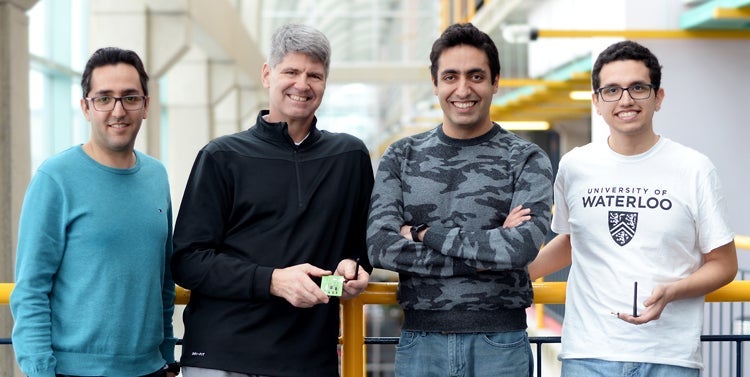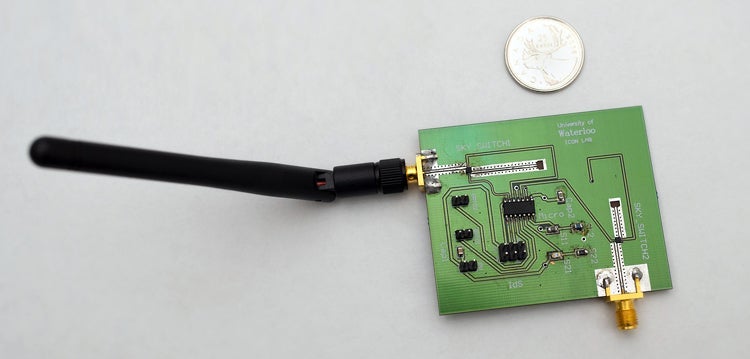Making your house “smart” could soon become cheaper and easier, thanks to new technology developed by researchers at the David R. Cheriton School of Computer Science.
Their recent study describes an approach that can be used to deploy, for the first time, battery-free sensors in a home using existing WiFi networks. Previous attempts to use battery-free sensors ran into some obstacles, making the efforts impractical. These hurdles include the need to modify existing WiFi access points, challenges with security protocols, and the need to use energy-hungry components.

L–R: Postdoctoral fellow Ali Abedi, Professors Tim Brecht and Omid Abari, master's candidate Farzan Dehbashi with the WiTAG WiFi-based backscatter system they developed (one device held by Tim Brecht and another by Farzan Dehbashi)
“If you look at the current sensor products, they need batteries, which nobody likes to have to change, but they will work with commodity WiFi,” explained Cheriton School of Computer Science Professor Omid Abari. “There has been recent research, which proposes approaches that don’t need batteries. But while they’re addressing the battery problem, they’re adding another issue — it doesn’t work with commodity WiFi devices.”
“So, our approach combines the best of these two worlds — it is battery-free and it works with commodity WiFi devices.”

WiTAG is a WiFi-based backscatter system for existing WiFi networks. It enables a battery-free tag to communicate data to existing WiFi devices without requiring any modifications.
The
new
communication
mechanism
outlined
in
the
study,
called
WiTAG,
could
revolutionize
the
smart
home
industry
as
the
Waterloo
researchers
have
shown,
for
the
first
time,
that
battery-free
sensors
can
be
used
with
common
WiFi
access
points.
WiTAG
will
enable
the
use
of
regular
WiFi
devices
for
reading
data
from
smart
devices,
unlike
existing
products
that
use
power-hungry
WiFi
transmitters
to
send
their
data
and
therefore
require
the
use
of
batteries.
WiTAG
uses
radio
frequency
(RF)
signals
as
a
power
source
and
makes
use
of
existing
WiFi
infrastructures
to
read
data
from
sensors
without
requiring
the
sensors
to
be
connected
to
the
WiFi
network,
which
makes
them
much
easier
to
deploy.
This
allows
smart
home
technologies
such
as
temperature
sensors,
light
sensors
and
potentially
wearable
devices,
such
as Fitbits
and
those
that
monitor
heart
rate
and
glucose
levels,
to
use
the
WiTAG
system.
“One
of
the
biggest
breakthroughs
is
the
fact
that
our
technique
works
with
encryption
enabled,”
said
Cheriton
School
of
Computer
Science
Professor
Tim
Brecht.
“The
prior
proposed
techniques
for
battery-free
communication
do
not
work
with
encrypted
WiFi
networks,
meaning
that
your
WiFi
network
could
not
use
a
password,
which
no
one
wants.”
The
researchers,
who
have
filed
a
provisional
patent,
implemented
WiTAG
and
created
the
first
prototype,
are
now
working
on
a
second
prototype.
They
are
also
developing
an
app
that
will
work
with
the
system
and
have
plans
to
support
a
wide
variety
of
applications.
“By
having
the
application
running
on
a
phone
without
any
other
modification
either
to
the
phone
or
to
the
access
point
we
can
read
sensor
data,”
said
Ali
Abedi,
a
postdoctoral
fellow
at
the
Cheriton
School
of
Computer
Science.
“Data
can
be
read
from
things
such
as
temperature
sensors
or
anything
you
see
in
smart
homes.”
A
paper
describing
the
system,
titled
WiTAG:
Rethinking
Backscatter
Communication
for
WiFi
Networks,
co-authored
by
Abari,
Brecht,
Abedi
and
Mohammad
Hossein
Mazaheri,
a
research
assistant
at
Waterloo,
recently
appeared
in
the
Proceedings
of
the
17th
ACM
Workshop
on
Hot
Topics
in
Networks.